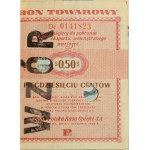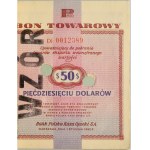Original booklet of the rarest PKO SA voucher designs from 1960. Current numbering, black MODEL stamp and double perforation. Czeslaw Miłczak notes similar pieces, but with single perforation and purple stamp.
These designs were created due to the increase in the number of Pewex stores, hence booklets were made up already on circulating pieces.
States various, low denominations clearly circulated, but most valuable, high denominations very well preserved, especially $50 and $100.
Total: Set of 10 pieces
During the People's Republic of Poland, in addition to National Bank bills, commodity vouchers circulated. They authorized the purchase of scarce goods unavailable in regular stores. Possession of dollar bills allowed the purchase of goods without standing in lines. These vouchers were the second "better currency".
In the late 1950s, a project was developed to create a nationwide network of stores where attractive goods could be purchased with foreign currencies. The economy of "People's Poland" needed foreign currency, and in order to keep it, it was decided to introduce substitute means of payment. These were commodity vouchers based on the U.S. dollar. People who received money transfers from abroad in foreign currency could not withdraw it in real banknotes, but only in the form of commodity vouchers. These substitute means of payment could be used to pay at Pewex stores (buying goods), Lokum (buying an apartment) or Polmot (buying a car). Goods vouchers entitled people to buy scarce goods out of line. Pekao vouchers were also issued at the National Bank of Poland. Merchandise vouchers lived to see three issues - 1960, 1969 and 1979, with the highest denomination in each being $100. They were printed with simple ornamental decoration limited to guilloches and denomination information. Commodity vouchers circulated in domestic circulation as the second "better" currency from January 1, 1960 to December 31, 1990.



















